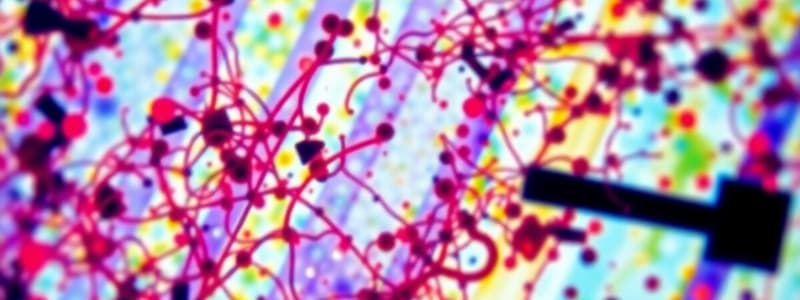Podcast
Questions and Answers
What determines the limit of resolution for a light microscope?
What determines the limit of resolution for a light microscope?
- The optical power of the ocular lens
- The type of specimen being observed
- The wavelength of light used and numerical aperture of the lens (correct)
- The size of the objective lens
What is the role of immersion oil when using a 100X objective?
What is the role of immersion oil when using a 100X objective?
- To increase light absorption
- To reduce the weight of the microscope
- To enhance resolution and numerical aperture (correct)
- To facilitate color observation of microbes
Which statement about magnification is true?
Which statement about magnification is true?
- Magnification can be increased without limit. (correct)
- Magnification is the primary factor in observing very small objects.
- Increased magnification guarantees greater resolution.
- Magnification is determined solely by the objective lens.
What is 'working distance' in microscopy?
What is 'working distance' in microscopy?
Why are unpigmented microbes often not visible under a light microscope?
Why are unpigmented microbes often not visible under a light microscope?
What is the resolution limit of light microscopes?
What is the resolution limit of light microscopes?
Which type of microscopy produces a dark image against a brighter background?
Which type of microscopy produces a dark image against a brighter background?
Which microscopy technique is particularly useful for analyzing cell structure at high detail?
Which microscopy technique is particularly useful for analyzing cell structure at high detail?
What characteristic of a lens is related to its strength?
What characteristic of a lens is related to its strength?
Which of the following is NOT a type of light microscope mentioned?
Which of the following is NOT a type of light microscope mentioned?
What type of microscope produces a bright image of the specimen against a dark background?
What type of microscope produces a bright image of the specimen against a dark background?
Which microscope is based on the principle of differing refractive indices between the cells and their surroundings?
Which microscope is based on the principle of differing refractive indices between the cells and their surroundings?
What is the primary use of differential interference contrast (DIC) microscopy?
What is the primary use of differential interference contrast (DIC) microscopy?
Which of the following is true about dark-field microscopy?
Which of the following is true about dark-field microscopy?
What is the visible outcome when using phase-contrast microscopy?
What is the visible outcome when using phase-contrast microscopy?
What is the primary reason for the high resolution of electron microscopy?
What is the primary reason for the high resolution of electron microscopy?
Why must specimens for transmission electron microscopy be stained?
Why must specimens for transmission electron microscopy be stained?
What does the scattering of electrons in a specimen indicate about its density?
What does the scattering of electrons in a specimen indicate about its density?
What preparation method involves coating a specimen with a heavy metal?
What preparation method involves coating a specimen with a heavy metal?
What is a significant advantage of using DIC microscopy for observing living cells?
What is a significant advantage of using DIC microscopy for observing living cells?
What is the main outcome of freeze-etching as a preparation method?
What is the main outcome of freeze-etching as a preparation method?
How does a fluorescence microscope produce an image?
How does a fluorescence microscope produce an image?
What type of microscopy is used to visualize biomolecules and generate high-resolution structures by freezing samples?
What type of microscopy is used to visualize biomolecules and generate high-resolution structures by freezing samples?
What role do fluorochrome-labeled probes play in microbiology?
What role do fluorochrome-labeled probes play in microbiology?
Which microscopy method produces a realistic 3D image of a specimen's surface features?
Which microscopy method produces a realistic 3D image of a specimen's surface features?
What is a critical limitation when preparing specimens for transmission electron microscopy?
What is a critical limitation when preparing specimens for transmission electron microscopy?
What is one major limitation of heat fixation in specimen preparation?
What is one major limitation of heat fixation in specimen preparation?
What characteristic defines basic dyes used in microbiological staining?
What characteristic defines basic dyes used in microbiological staining?
What is the primary function of fixation in microscopy?
What is the primary function of fixation in microscopy?
What is the resolution capability of confocal scanning laser microscopy (CSLM)?
What is the resolution capability of confocal scanning laser microscopy (CSLM)?
What is one application of fluorescence microscopy in medical microbiology?
What is one application of fluorescence microscopy in medical microbiology?
What is the purpose of differential staining in bacteriology?
What is the purpose of differential staining in bacteriology?
Why might cells appear brightly colored in DIC microscopy?
Why might cells appear brightly colored in DIC microscopy?
Flashcards are hidden until you start studying
Study Notes
Microscopy Overview
- Microorganism sizes range from nanometers (viruses) to approximately 200 micrometers (larger protists and bacteria).
- Light microscopes are the fundamental tools for microbiologists, crucial for studying microbial structures.
- Magnification ability is not limited; however, resolution (ability to distinguish two objects) is constrained by physical properties of light, with a limit of 0.2 µm for light microscopes.
Principles of Light Microscopy
- Different light microscopy techniques include:
- Bright field
- Dark field
- Phase contrast
- Differential interference contrast
- Fluorescence microscopy
- Confocal scanning laser microscopy
- Use of lenses is essential; they bend light to create images, with short focal lengths providing higher magnification.
- Resolution is influenced by the wavelength of light and numerical aperture of the lens.
Bright-Field Microscopy
- Examines both stained and unstained specimens, yielding dark images against a bright background.
- Total magnification is the product of the ocular and objective lens magnifications.
Dark-Field Microscopy
- Utilizes scattered light from the specimen, creating a bright image on a dark field.
- Particularly useful for observing live, unstained preparations and certain bacteria (e.g., Treponema pallidum).
Phase Contrast Microscopy
- Invented by Frits Zernike in 1936; enhances contrast by exploiting differences in refractive index.
- Provides dark cells against a light background, effective for observing microbial movement.
Differential Interference Contrast (DIC) Microscopy
- Detects differences in refractive indices and specimen thickness, using polarized light.
- Produces three-dimensional images with bright, colorful appearances for living cells and structures that are invisible in bright-field microscopy.
Fluorescence Microscopy
- Uses specific wavelengths of light to excite fluorochromes, resulting in emitted fluorescence from specimens.
- Practical for identifying pathogens and localizing proteins within cells.
Confocal Scanning Laser Microscopy (CSLM)
- Combines computerized microscopy with laser technology for sharp, three-dimensional images.
- Capable of focusing on single layers of a specimen, achieving a resolution of 0.1 µm.
Sample Preparation and Staining
- Staining enhances specimen visibility, morphological feature accentuation, and specimen preservation.
- Fixation via heat or chemical methods preserves structural integrity; chemical fixation is preferred for delicate organisms.
- Dyes increase contrast, aiding visibility of internal and external structures.
Electron Microscopy Techniques
-
Transmission Electron Microscopy (TEM)
- Provides high resolution (down to 0.2 nm) using electron wavelengths much shorter than light.
- Requires ultra-thin specimens (20–60 nm) and contrast-enhancing staining methods.
-
Scanning Electron Microscopy (SEM)
- Electron beams scan surfaces to create detailed three-dimensional images.
- Specimens are coated with heavy metals (e.g., gold) to enhance surface visuals.
-
Cryo-Electron Microscopy
- Achieved a Nobel Prize in Chemistry (2017); visualizes proteins via rapid freezing and multiple imaging angles.
- Generates high-resolution three-dimensional images of biomolecules.
Takeaways
- Familiarity with various microscopy techniques is essential for selecting the appropriate method for specific research inquiries in microbiology.
Studying That Suits You
Use AI to generate personalized quizzes and flashcards to suit your learning preferences.




